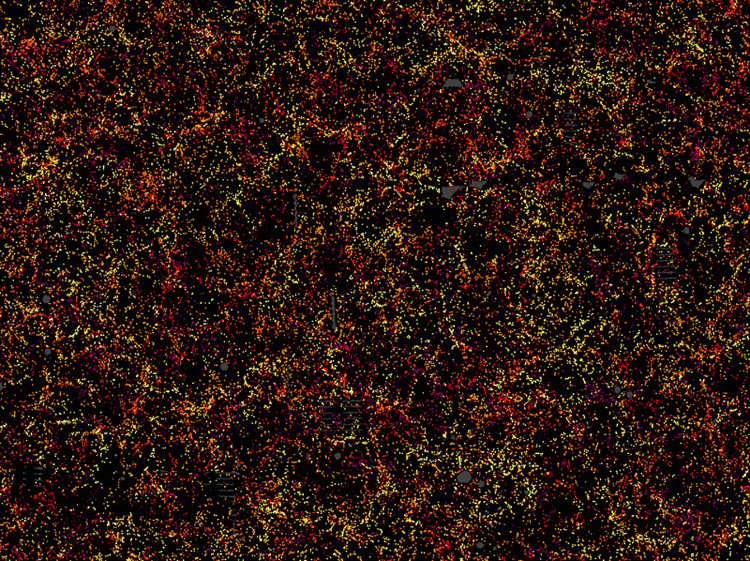The 3D universe map contains 1.2 million galaxies that prove the universe expanded rapidly
These yellow red dots are not stars but some of the 1.2 million galaxies that astronomers have observed after the recent massive cosmic sweep to establish an astronomical map. The largest 3D ever . This is not just a new record set in astronomy but from this map, researchers also have more evidence of the mysterious material called dark energy which is thought to be the cause of the Universe. Expansion pillars with increasing speed.
The map covered 650 million light-years of space - equivalent to a quarter of the sky and was created by the cooperation of hundreds of researchers from the Baryon spectral oscilloscope project ( BOSS) . BOSS is a super project of the project of understanding and digitizing Sloan III Great Wall (SDSS-III), measuring the amount of sound waves from the beginning of the universe based on the traces of the remaining background radiation. BigBang. Another goal of the project is to establish a map of galactic distributions and distances over time.
Not only does this provide a beautiful view of the universe, but this map also allows scientists to conduct precise measurements of the cosmic expansion from the past to the present, through It helps to find an explanation of dark energy that is thought to cause the universe to expand but is still causing headaches for scientists.

Yellow red dots are galaxies that astronomers observe.
When Albert Einstein first proposed universal relativity in 1916, he did not know that the universe was expanding. Like other contemporaries, he thought that the size of the universe was fixed and the only way he could make his equation true to a static universe was to use a cosmological constant, signed lambda effect . Without this constant, the universe could shrink or expand.
By 1929, Einstein had to change his mind when astronomer Edwin Hubble discovered that the universe was expanding. Einstein called this the biggest mistake of his career. Later in 1998, two groups of physicists who had studied supernova found that not only are galaxies moving away from us, but the speed of movement is also faster.
To explain this, they hypothesize about dark energy even though they don't know exactly what it is ? One of the most promising explanations is that Einstein was on the right track when using the cosmological constant - except for the present, instead of keeping the universe stationary, this constant is related to a force against gravity. leads, making the universe expand and expand quickly. And the data obtained from the BOSS project this time once again confirms that it is true.
As can be seen in the image above, each dot represents the position of a galaxy 6 billion years ago but only consists of 1/20 of the sky above us, containing a 6 billion universe segment. light years, 4.5 billion light-years high and 500 million light-years thick. More precisely, this map contains 48,741 galaxies and this is only 3% of the galaxy's total data that the BOSS collected among the 100 million galaxies of the entire universe as estimated before.
The color refers to the relative distance of galaxies to Earth, the closer the object will be yellow, the more purple the farther away from the Earth. Small gray pools represent the place where data has not been collected yet. Galaxies are clustered, showing superstructures and spaces. In an average calculation, the map above contains about 4,874,100,000,000 (4,8471x10 ^ 15) stars. And remember that this also represents only part of the sky. If there is a more complete map of the entire galaxies of the universe, there are 100 thousand million stars.

The picture above shows galaxies in 3-dimensional space.
The picture above shows galaxies in 3-dimensional space. The rectangle on the left is cut at an angle of 1000 square degrees in the sky, containing about 120,000 galaxies, accounting for 10% of all data collected. Brighter areas have more galaxies and vice versa. The project leader, Rita Tojeiro at the University of St. Andrews said: "We see the deep connection between the cosmic microwave background 400,000 years after the Big Bang with galaxy clusters 7-12 million years later."
On the other hand, data obtained from BOSS also shows that dark energy - which determines the expansion of the universe - is consistent with the cosmological constant with an error rate of only 5%. This map fits perfectly with the standard model of the universe (a single cosmological universe) and from there it reinforces popular scientific theories before now. In the near future, it will help scientists better understand dark energy and the problems surrounding it still contain many mysteries as its name suggests.
- How many galaxies in the universe?
- The largest structure in the universe contains just 1,600 galaxies
- The 84 million star image is at the center of the universe
- Set of three galaxies in the dawn of the universe
- Decoding adds a mystery of the universe
- 5 most impressive galaxies in the universe
- We live in the end of the universe
- Discover 'living fossil' galaxies in the universe
- Detecting a group of 'ghost galaxies'
- The mystery of the dead galaxies
- New Hubble telescope image of the hybrid galaxy UGC 12591
- Discover the birth of ancient galaxies
 Why does steam cause burns worse than boiling water?
Why does steam cause burns worse than boiling water? Lightning-fast octopus is amazing
Lightning-fast octopus is amazing Video: The secret to quickly fold clothes in just 2 seconds for busy people
Video: The secret to quickly fold clothes in just 2 seconds for busy people The eel waving off his head still bites the can of water
The eel waving off his head still bites the can of water